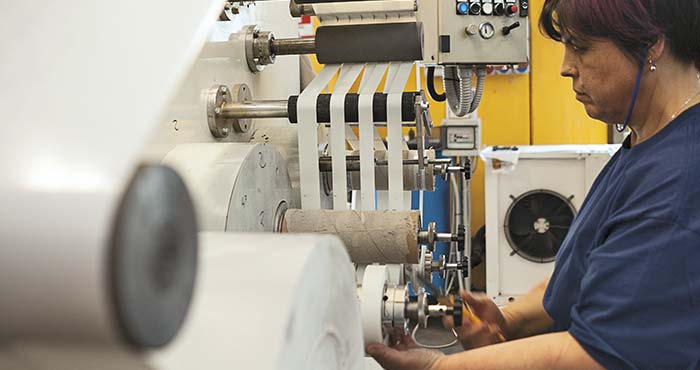
Kiss-Cutting


Kiss-cutting is a process very similar to die-cutting, but the blade cuts only partially, hence it is also called "half-cut". This procedure is performed on adhesive-coated flexible materials that are accompanied by a sacrificial silicone paper: the cut involves only the adhesive-coated product while the backing paper remains intact. In other words, the blade is adjusted so that it "kisses" the protective paper without cutting it, hence the name of the process. This procedure can be performed on material with a maximum width of 100 mm.
The process has been developed over the years for the production of adhesive labels to be used in the electrical sector. They have the same technical characteristics as adhesive tapes, but with the advantage of having pre-cut pieces of fixed length. This makes it easier for the customer to estimate product consumption while ensuring that a defined and controlled amount of material is used in the process.
Thanks to Filmcutter's experience and collaboration with local customers, Filmcutter has also developed a small dispenser machine that can be purchased by the customer along with the material. This small device facilitates the use of labels by personnel and speeds up the operation itself.
Main Benefits
This cutting technique is mainly used in the manufacturing industry to produce adhesives, labels, flexible materials, and other products that require precision and cleanliness in cuts. This cutting method involves scoring an upper layer of material without fully penetrating the underlying layer, thus creating a cut that remains attached to the backing matrix. This allows finished products to be easily extracted without damaging the underlying backing matrix.
The kiss-cutting process is performed using a specially designed machine called a die-cutting press, which is equipped with a precise and controlled cutting blade. During the process, the material to be cut is placed on the die-cutter platform, and the cutting blade is lowered to make the desired cut. The applied pressure is calibrated to cut only the upper layer of material without damaging the underlying layer or backing matrix.
One of its main features is its precision and repeatability. Thanks to the ability to precisely control cutting depth and pressure, it is possible to achieve uniform and precise results on a wide range of materials, including adhesives, plastic films, fabrics, and more. This precision is essential to ensure the quality and reliability of finished products, minimizing waste and production defects.
Another advantage of this process is its versatility. This cutting method can be used to produce a variety of different shapes and sizes, from simple to complex. Additionally, multiple scores can be made on a single sheet of material, allowing for efficient production of mixed and customized batches.
When is it used?
Kiss-cutting is widely used in many industries, including labeling, packaging, automotive, consumer electronics, and more. In the labeling industry, for example, it is used to produce adhesive labels with a removable backing, allowing operators to easily extract individual labels from the backing matrix and apply them to final products.
Furthermore, the kiss-cutting process is particularly suitable for producing flexible materials such as plastic films and fabrics that require precise cutting without compromising their structural integrity. This makes it an ideal choice for producing membranes, gaskets, coating materials, and more.
In conclusion, the kiss-cutting process is a versatile, precise, and efficient cutting technique used in manufacturing to produce a wide range of products. Thanks to its precision, repeatability, and versatility, kiss-cutting has become a preferred method for producing labels, adhesives, flexible materials, and more, ensuring the quality and reliability of finished products.

